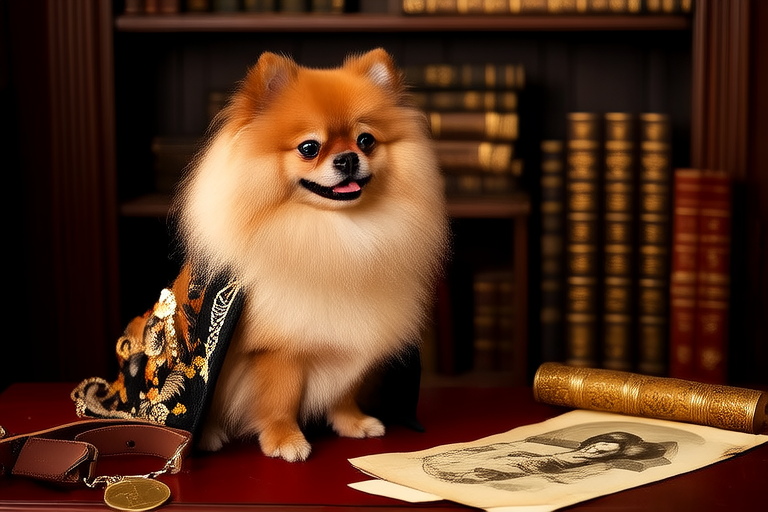The Evolution of the Pomeranian Breed
The Pomeranian, a small, lively breed of dog, has a rich and fascinating history that traces back to the region of Pomerania, located in present-day Poland and Germany. Originally bred as a larger working dog, this breed has undergone significant transformations over centuries, evolving into the beloved companion animal we know today. This article explores the origins and evolution of the Pomeranian, highlighting its transition through selective breeding, the influence of key historical figures, and the factors contributing to its rise in popularity.
Origins and Early History
The Pomeranian breed originated in the region of Pomerania, named after the Pomeranian people, an ancient Germanic tribe. In the early days, Pomeranians were much larger dogs, similar in size to Samoyeds or Keeshonds, and were used primarily as herding and guard dogs. These dogs were highly valued for their strength and intelligence, making them excellent workers in the harsh northern climates where they were originally bred.
The breed’s journey began in earnest during the Middle Ages when it was brought to England by merchants and traders. The first documented evidence of Pomeranians in England dates back to the 18th century. During this period, the breed was still relatively large and robust, more akin to the Spitz family of dogs from which they descended. It was during this time that the breed started to gain recognition beyond its practical uses.
Selective Breeding and Size Reduction
The transition from a larger working dog to the smaller, more delicate companion dog seen today is largely attributed to selective breeding practices that took place in the late 18th and 19th centuries. Breeders sought to reduce the size of the Pomeranian while retaining its distinctive appearance and character. This process involved crossbreeding with smaller breeds, such as toy spaniels and Italian greyhounds, to achieve the desired diminutive stature.
The reduction in size did not come without controversy. Many breed enthusiasts argued that the breed had lost its original purpose and essence. However, the smaller version of the Pomeranian proved to be more adaptable and appealing to a wider audience, particularly as a companion animal.
Influence of Historical Figures
One of the most influential figures in the history of the Pomeranian breed is Queen Victoria of England. Queen Victoria was a passionate dog lover and played a pivotal role in the breed’s transformation and subsequent rise in popularity. She acquired a small Pomeranian named Marco in 1888 and became deeply attached to him. Marco’s death in 1894 led the Queen to acquire another Pomeranian, Turi, further solidifying her affection for the breed.
Queen Victoria’s fondness for Pomeranians was well-documented, and her ownership of these dogs helped to elevate their status among the British aristocracy. Her influence extended beyond her personal preference; she actively participated in breeding programs and showed her Pomeranians at prestigious dog shows. This royal endorsement significantly boosted the breed’s popularity, both in England and abroad.
Physical Characteristics and Temperament Changes
The physical characteristics of the Pomeranian have changed dramatically over time. Originally, the breed was robust and muscular, with a thick double coat designed to withstand cold weather. Today’s Pomeranians are much smaller, typically weighing between 3 to 7 pounds, and have a dense, fluffy coat that comes in a variety of colors. Their compact size and attractive appearance make them ideal companions for apartment living and urban environments.
Besides physical changes, the temperament of the Pomeranian has also evolved. Early Pomeranians were more reserved and protective, traits that were beneficial for their roles as herders and guards. As the breed was selectively bred for size reduction, their temperament shifted to become more outgoing, playful, and affectionate. This change made them better suited for life as companion animals. Despite their diminutive size, Pomeranians retain a spirited and independent nature, often displaying a strong-willed personality.
Rise in Popularity as a Household Pet
The combination of physical attributes and temperament changes contributed significantly to the Pomeranian’s rise in popularity as a household pet. Their small size, coupled with their charming appearance and friendly disposition, made them ideal companions for families and individuals alike. Additionally, their adaptability to various living situations, including city apartments and suburban homes, further enhanced their appeal.
By the late 19th century, Pomeranians had become a common sight in upper-class households across Europe and North America. Their presence in these settings was not merely ornamental; they were cherished members of the family, providing companionship and joy to their owners. The breed’s popularity continued to grow throughout the 20th century, cementing its status as one of the most beloved small dog breeds.
Modern Care and Considerations for Prospective Owners
Today, the Pomeranian remains a popular choice for those seeking a small, lively companion. However, potential owners must be aware of certain considerations to ensure the health and happiness of their pets. Regular grooming is essential due to the breed’s dense coat, which requires brushing several times a week to prevent matting and tangling. Additionally, Pomeranians are prone to certain health issues, such as luxating patellas and tracheal collapse, necessitating routine veterinary check-ups and possibly specialized care.
Training and socialization are also crucial aspects of Pomeranian care. These dogs are intelligent but can be stubborn, requiring consistent and positive reinforcement training methods. Early socialization helps to mitigate any potential behavioral issues and ensures that your Pomeranian becomes a well-adjusted member of your household.
In conclusion, the Pomeranian breed has undergone a remarkable transformation from its origins as a larger working dog in Pomerania to the small, popular companion dog known today. Through selective breeding, the influence of historical figures like Queen Victoria, and shifts in physical characteristics and temperament, the Pomeranian has secured its place as one of the most beloved small dog breeds. For those considering adopting a Pomeranian, understanding the breed’s unique needs and providing appropriate care will ensure a rewarding and fulfilling relationship with these delightful dogs.
